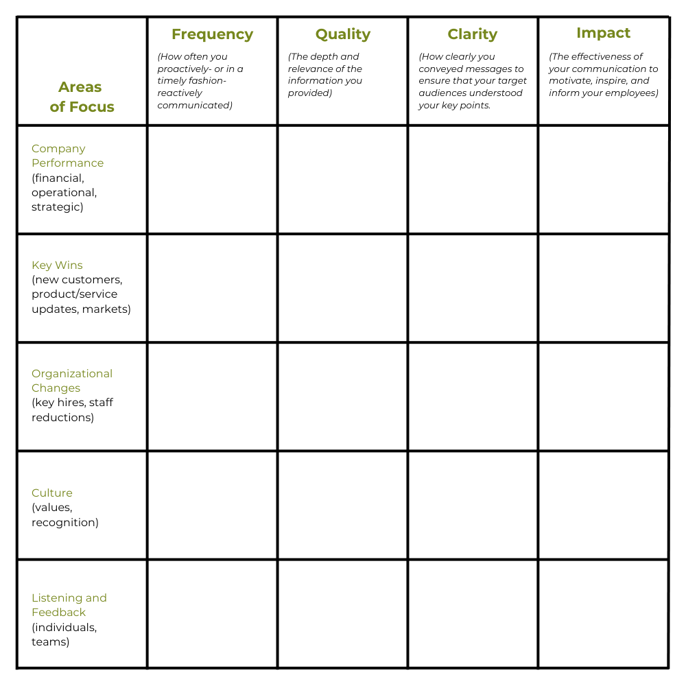"The two words 'information' and 'communication' are often used interchangeably, but they signify quite different things. Information is giving out; communication is getting through." - Sydney J. Harris
For my CEO, C-suite, and executive team coaching and advisory clients, 2023 was a year filled with diverse challenges connected by a common thread: an under appreciation for the art of clear, consistent, and impactful communications. CEOs had many opportunities to showcase values-driven and culturally sensitive leadership around staff reductions, budget tightening, strategy pivots, key hires and departures, updated workplace policies, or response to world events. Yet, they often struggled. With increased expectations to be more proactive and responsive communicators, old habits often got in the way, as some took an information sharing approach rather than a communication approach focused on “getting messages through” to head and heart.
And, unlike CEOs and senior leaders in large organizations, the ripple effects of great (and poor) communications and messaging in smaller, fast-moving companies have outsized impact on employee morale, motivation, and commitment.
Sources of Challenge
While the art of clearly communicating messages to inspire and recognize employees in good times and offering messages of honesty and transparency in challenging times can be a high-growth CEO’s Achilles heel., not all CEOs and executives struggle here. Still, there are reasons some might have a difficult time communicating effectively when the need is greatest.
1. Lack of CEO experience: The leader may have a compelling vision and deep technical or product expertise but limited experience in executive level communication or conveying complex business information to employees.
2. Emotional attachment: The leader may have a deep emotional connection to their company, which can make it challenging to deliver negative news or admit mistakes. Or they might fear that transparency could negatively impact morale or company reputation.
3. Information overload: With a multitude of growing responsibilities, its often difficult to prioritize communication and timely updates against the pressures to perform and deliver results.
4. Rapid growth: Rapid growth and change make it challenging to adapt and maintain effective communication channels.
5. Lack of peer feedback: CEOs may not have a strong peer network to get feedback on their communication style and effectiveness.
6. Insularity: Some CEOs can become insulated, surrounded by a close-knit group of advisors or loyal employees, limiting exposure to diverse perspectives, leading to communication blind spots.
Take a Communication Tactical Pause
As you look ahead to 2024, take a moment and reflect on your 2023 communication performance. Referencing the grid below, gather data from your leadership team or select company employees to score your performance in each impact area.
Using a scale of 1-5 (5 being highest; 1 being lowest), have them rate you across four key criteria: frequency, quality, clarity, and impact. Once you gather and compare this feedback, consider common themes and ways to move forward in 2024.

Looking ahead with optimism and possibility, I know many CEOs and leadership teams may be organizing company kick off meetings or President’s club reward and recognition off-sites to align, connect, inspire, and build momentum for the new year.
Typically high on emotive imagery, enthusiastic speeches, visuals and fun, kick-offs and reward trips can serve as useful tools to reset the dial on communications and messaging. Still, many of these events rapidly become distant memories as the performance year unfolds. In many ways, they become missed opportunities as clear, impactful, and concise information-sharing and messaging requires consistency, a commitment to regular listening, and contextual framing (or reframing) throughout the year.
To set yourself up for success, there are some communication norms you can establish right from the get-go:
o Be Clear, Not Cryptic: Avoid jargon. Be direct and straightforward. Remember, clear communication is not meant to come across as a riddle. Simplify your messages.
o Embrace Good and Bad News: While not every message can be positive, be empathic and candid. Employees generally appreciate transparency.
o Be Consistent: Establish a regular cadence, foster transparency, and demonstrate your willingness to address emerging challenges head-on.
o Be a Storyteller: Humans recall stories better than facts and figures. Share stories that illustrate your points and convey your messages effectively. If necessary, visualize data with simple charts, graphs, or infographics to make the information more easily digestible.
o Take a "what's in it for you?" Approach: When delivering messages about impending changes or challenges, explain how these developments will affect employees individually, exuding that you value their concerns and interests.
Delivering in the New Year
From every macroeconomic and business indicator, 2024 promises to be a volatile mix of growth and risk -- political, economic, technological, environmental, and social. As you navigate your growth and profitability agendas, open yourself up to enhancing your communications approach and committing to better preparation for the opportunities and challenges that will invariably arise:
1. Invest Time and Practice Your Communication Skills
Work on developing your oral, stand-up and facilitation skills through coaching, training, or mentorship. Seek guidance from a board member. Consider enrolling in an executive communication course to further refine your abilities. Effective communication can always be honed and improved.
2. Seek Feedback
Actively solicit feedback from employees, advisors, or a board member to assess the effectiveness of your communication efforts in a timely fashion. Make sure your leadership team feels comfortable providing honest input and suggestions for improvement. Be willing to accept, own and apply the feedback.
3. Prioritize Transparency
Make transparency a core value and ensure employees understand where the company stands relative to its vision, mission, and performance at all times – good or bad. Transparency is a double-edged sword, but – done well – can build trust and a culture of open communication where employees feel valued and informed and deepen their affiliation. When people sense a communication gap, they very quickly fill it with rumor and speculation, which is more dangerous and culture-killing than telling them what's really going on.
4. Delegate Responsibility
As the company grows, consider delegating communication tasks to experienced Communications and PR professionals to own and assist in crafting clear and impactful messages which reflect your voice.
5. Stay Connected
Maintain open lines of communication with employees at all levels to foster a culture of feedback and open dialogue. Use a variety of channels, from regular team meetings, skip-level breakfast/coffee, stand-ups on video or IRL, to anonymous suggestion boxes, etc. to ensure that every voice is heard. Regardless of your approach, commitment is key, as this must be seen as a business imperative.
6. Adapt
Adjust your communication strategies to meet the evolving needs of the modern workplace and workforce, especially in hybrid and remote settings. Be flexible and open to new ways of connecting.
You’ve arrived at this place, having built, or taken lead of, your high-growth company. It’s an exciting place and position. But, arguably most of all, it’s a role that benefits from a commitment to continuous self-improvement, and – given the array of challenges nowadays – expertise as a clear and effective communicator.
You can only do so much. It’s critical your employees clearly know where you stand, where the organization stands, and where they stand. That level of understanding will not only deepen engagement, but also engender the loyalty required to embrace, tackle, and overcome the collective challenges which await you.
2024 is yours to shape. Lead it with a strong, powerful, clear, and timely voice.


